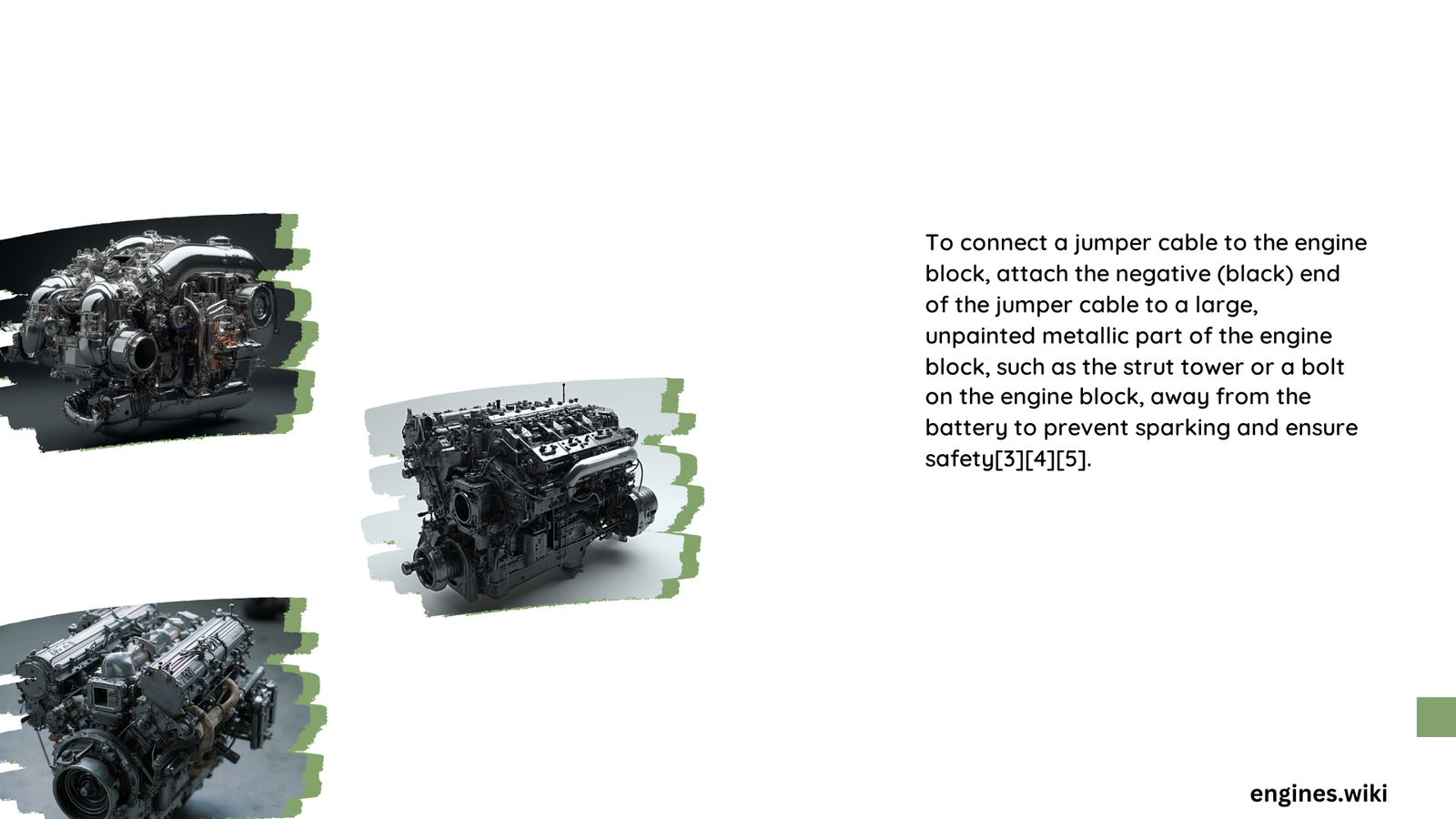Connecting jumper cables to an engine block is a crucial skill for any driver. This guide provides detailed information on the correct location to attach jumper cables, focusing on the engine block connection. We’ll explore the importance of proper grounding, specific connection points, and safety measures to ensure a successful jump-start without damaging your vehicle’s electrical system or risking personal injury.
Where Should You Connect the Jumper Cable on the Engine Block?
The negative (black) jumper cable should be connected to a clean, unpainted metal surface on the engine block or frame of the vehicle with the dead battery. This serves as a ground connection and helps prevent sparks near the battery, which can be dangerous due to the presence of flammable gases.
What Are the Specific Connection Points on the Engine Block?
- Alternator Bracket: Often a sturdy, easily accessible point
- Engine Lift Hook: Typically a solid metal component
- Unpainted Bolt on Engine Block: Ensure it’s free of grease and corrosion
- Dedicated Ground Stud: Some vehicles have a specific grounding point marked with a ground symbol
Why Not Connect Directly to the Negative Battery Terminal?
Connecting the negative jumper cable directly to the dead battery’s negative terminal can cause sparks, potentially igniting hydrogen gas emitted by the battery. This is why connecting to the engine block or frame is safer.
What Are the Steps to Properly Connect Jumper Cables?

- Position the vehicles close enough for the cables to reach
- Identify the positive and negative terminals on both batteries
- Connect the red (positive) cable to the positive terminal of the dead battery
- Connect the other end of the red cable to the positive terminal of the good battery
- Connect the black (negative) cable to the negative terminal of the good battery
- Connect the other end of the black cable to an unpainted metal part of the engine block or frame of the vehicle with the dead battery
- Start the vehicle with the good battery and let it run for a few minutes
- Attempt to start the vehicle with the dead battery
What Safety Precautions Should You Take?
- Wear safety glasses to protect your eyes from potential sparks or battery acid
- Ensure both vehicles are in park or neutral with parking brakes engaged
- Turn off all electrical components in both vehicles before connecting cables
- Keep hands and loose clothing away from moving engine parts
- Never let the cable clamps touch each other once connected to a power source
How Do You Identify the Correct Grounding Point on Different Vehicle Types?
| Vehicle Type | Common Grounding Points |
|---|---|
| Sedan | Engine block, alternator bracket |
| SUV | Frame rail, engine mount |
| Truck | Chassis, engine lift hook |
| Hybrid | Consult manual for specific grounding point |
What Are the Risks of Incorrect Jumper Cable Connection?
- Electrical System Damage: Reversed polarity can fry sensitive electronics
- Battery Explosion: Improper connections can cause sparks and ignite battery gases
- Personal Injury: Risk of electrical shock or acid burns from damaged batteries
- Engine Damage: Incorrect connections can lead to short circuits and engine component failure
How Can You Ensure a Secure Connection to the Engine Block?
- Clean the Connection Point: Use a wire brush to remove any rust or debris
- Check Cable Clamp Condition: Ensure clamps are not corroded or damaged
- Apply Firm Pressure: Make sure the clamp grips the metal surface tightly
- Wiggle Test: Gently shake the connection to ensure it’s secure
- Visual Inspection: Look for any signs of loose connections or sparking
What Are the Signs of a Good Connection?
- No visible sparks when making the final connection
- The dead vehicle’s electrical systems show signs of life
- The engine of the vehicle with the good battery doesn’t stall when connected
What Should You Do If You Can’t Find a Suitable Engine Block Connection Point?
- Consult the Owner’s Manual: Look for manufacturer-recommended grounding points
- Check for a Grounding Strap: Some vehicles have a dedicated metal strap for grounding
- Look for Large Metal Components: Steering components or suspension parts can sometimes be used
- Use a Battery Terminal Cleaning Tool: If you must use the negative terminal, clean it thoroughly first
How Do Different Engine Types Affect Jumper Cable Connection?
- Diesel Engines: Often have more accessible grounding points due to larger engine compartments
- Electric Vehicles: Require special procedures and should not be jump-started conventionally
- Hybrid Vehicles: May have specific grounding points to avoid damaging hybrid system components
What Are Common Mistakes When Connecting Jumper Cables to the Engine Block?
- Connecting to a moving part of the engine
- Using a painted surface instead of bare metal
- Connecting to a plastic component mistaken for metal
- Overlooking manufacturer-specific grounding points
- Using corroded or weak connection points
How Can You Troubleshoot a Failed Jump-Start Attempt?
- Check All Connections: Ensure all clamps are securely fastened
- Inspect Cable Condition: Look for frayed or damaged cables
- Clean Battery Terminals: Remove any corrosion on battery posts
- Rev the Engine: Increase RPM of the good vehicle to boost charging
- Wait Longer: Allow more time for the dead battery to receive charge
By following these guidelines, you can safely and effectively connect jumper cables to the engine block, ensuring a successful jump-start without risking damage to your vehicle or personal injury. Remember, if you’re unsure about any aspect of jump-starting a vehicle, it’s always best to consult a professional mechanic or roadside assistance service.
